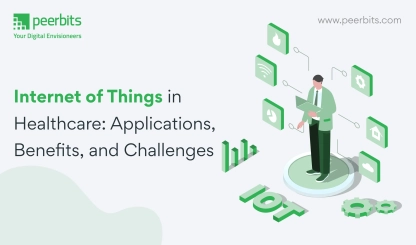Asset tracking has come a long way, moving from traditional manual methods to modern technologies like RFID (Radio Frequency Identification) and IoT (Internet of Things).
These innovations are changing how businesses track and manage their assets in real-time, offering better accuracy, efficiency, and data insights.
The RFID market, expected to grow from USD 12.61 billion in 2025 to USD 25.24 billion in 2033, at a CAGR of 9.1%, shows just how essential these technologies are becoming in asset management.
As more industries adopt RFID and IoT, the opportunities to improve operations, cut costs, and gain better visibility are growing.
In sectors like logistics, manufacturing, and healthcare, RFID and IoT are enhancing asset tracking. This blog will explore how these technologies are making an impact and why they’re essential for businesses seeking better efficiency and control.
Understanding RFID and IoT
RFID (Radio-Frequency Identification) is a technology that has quietly woven itself into the fabric of modern life. It involves the use of small electronic tags that can store and transmit information. These tags are equipped with a unique identifier and an antenna, enabling them to communicate wirelessly with RFID readers.
When an RFID reader sends out radio waves, it powers the RFID tags, prompting them to transmit their data. This data can include anything from simple identification numbers to more complex information about a product's origin, history, or status.
Through IoT app development, these "things" can communicate with each other and with centralized systems, sharing data and enabling smarter, more automated processes.
Imagine your thermostat adjusting itself based on your daily routine, your fridge ordering groceries when you're running low, or your car communicating with traffic lights to optimize your commute – these are all real-world applications of IoT.
At first glance, RFID and IoT might seem like separate technologies with distinct applications, but their synergy is where the true magic happens. RFID provides precise, real-time data on individual objects, allowing us to track and manage them at an unprecedented level of detail.
When integrated into the broader IoT ecosystem, RFID tags become valuable data sources, feeding information into the internet-connected network.
Radio-Frequency Identification
RFID technology employs radio waves to identify and track assets, be they products, equipment, or even living entities like animals. The core components of RFID include RFID tags or labels attached to assets and RFID readers or scanners that wirelessly communicate with these tags. Each RFID tag boasts a unique identifier, facilitating individual asset tracking.
Delve Deeper: RFID tags come in various forms, including passive (powered by the reader's signal), active (featuring their power source and longer-range capabilities), and semi-passive (which combine elements of both). Understanding these distinctions is crucial for tailoring asset tracking systems to specific needs.
Read more: How RFID works & its impact on inventory management?
IoT (Internet of Things)
The IoT, a revolutionary concept, connects physical objects, devices, and sensors to the internet. These interconnected devices continuously collect and transmit data in real-time, allowing organizations to remotely monitor, control, and analyze assets. IoT serves as the infrastructure that enables seamless functioning of asset tracking systems.
Delve Deeper: IoT encompasses an extensive ecosystem of sensors, gateways, cloud platforms, and applications. These components collaborate to create a cohesive system that transforms asset data into actionable insights, making it a driving force behind the digital transformation of asset management.
Use Cases for RFID and IoT in Asset Tracking
In an era where information is the lifeblood of business operations, the ability to track and manage assets efficiently and accurately holds paramount importance. This challenge has given rise to the convergence of two groundbreaking technologies: Radio-Frequency Identification (RFID) and the Internet of Things (IoT).
These powerful systems, individually impactful in their own right, have joined forces to revolutionize asset tracking across a multitude of industries.
In this exploration, we venture into the realm of RFID and IoT, focusing specifically on their remarkable applications in asset tracking. We will uncover how these technologies, with their ability to capture, transmit, and analyze data in real-time, are reshaping the way organizations safeguard and optimize their valuable resources.
From manufacturing floors and healthcare facilities to logistics hubs and smart cities, RFID and IoT offer a dynamic duo of solutions that provide unparalleled visibility, control, and efficiency.
Whether you're an industry professional seeking to enhance your asset management strategies or simply intrigued by the transformative potential of these technologies, this guide will illuminate the diverse use cases, benefits, and future prospects of IoT and RFID for asset tracking.
Join us on this journey as we explore how RFID and IoT are driving innovation and reshaping the way we manage our most valuable assets.
Asset Tracking
In a manufacturing facility, IoT and RFID technologies are seamlessly integrated for efficient asset tracking. RFID tags with unique identification information are affixed to assets, while strategically placed IoT devices, including RFID readers and sensors, continuously monitor and transmit data over the internet.
This real-time tracking provides precise asset location information and enables real-time monitoring of conditions like temperature and humidity. The facility benefits from accurate inventory management, optimization of asset utilization, enhanced security, and loss prevention, as well as predictive maintenance scheduling based on historical data.
The combination of IoT and RFID technology streamlines asset tracking, reducing costs and enhancing overall operational efficiency.
Cold Chain Monitoring
RFID and IoT play a critical role in cold chain monitoring, ensuring the safe and efficient transportation of temperature-sensitive goods, such as pharmaceuticals, vaccines, and perishable foods.
RFID tags and IoT sensors can continuously monitor and transmit temperature and humidity data, allowing for real-time tracking and management of cold chain logistics.
If temperature deviations occur, automated alerts can be triggered, enabling immediate corrective actions to prevent spoilage or compromised product quality.
This technology also offers comprehensive data logging and analytics, helping companies meet regulatory compliance requirements and maintain the integrity of their cold chain, ensuring that products reach consumers in optimal condition.
Supply Chain Visibility
IoT technology complements the supply chain visibility offered by RFID, creating a robust ecosystem for efficient and transparent logistics. In this integrated approach, IoT sensors are incorporated into the RFID system to provide real-time data and insights throughout the supply chain.
These sensors monitor factors such as temperature, humidity, and environmental conditions, ensuring the integrity of sensitive products.
This combination enables proactive decision-making by alerting stakeholders to any deviations from ideal conditions, guaranteeing product quality and safety.
IoT extends the benefits of RFID technology to route optimization through data analytics, offering insights into traffic patterns, weather conditions, and delivery schedules.
Together, IoT and RFID empower organizations to achieve end-to-end visibility, improve efficiency, reduce waste, enhance product safety, and ensure timely and secure delivery of goods across the supply chain.
Predictive Maintenance
RFID and IoT technologies provide powerful tools for predictive maintenance across various industries. By embedding RFID tags and IoT sensors in critical equipment, companies can continuously monitor the condition and performance of assets in real time. This data is then processed and analyzed, allowing for the early detection of potential issues or anomalies.
Predictive maintenance enables proactive and scheduled repairs or replacements, reducing downtime, extending asset lifecycles, and ultimately saving on maintenance costs.
Whether in manufacturing, healthcare, or transportation, this technology-driven approach ensures that equipment remains in optimal working condition, enhancing operational efficiency and reliability.
Read more: Predictive maintenance and quality control in Iot
Quality Control
RFID and IoT technologies play a significant role in quality control processes across various industries. In manufacturing, RFID tags can be attached to individual components or products, while IoT sensors collect data on environmental conditions and equipment performance. This real-time information is then analyzed to identify deviations from quality standards.
Automated alerts can trigger immediate corrective actions, helping prevent defects and ensuring consistent product quality.
In addition, RFID and IoT data can be used to track and trace products throughout the supply chain, aiding in identifying the source of quality issues and streamlining recalls.
This technology-driven approach enhances quality control, reduces waste, and improves overall product quality and customer satisfaction.
Benefits of Combining RFID and IoT for Asset
The convergence of Radio-Frequency Identification (RFID) and the Internet of Things (IoT) has opened a gateway to a new era of asset tracking and management.
Together, these technologies offer a dynamic synergy that empowers organizations to achieve unprecedented levels of visibility, efficiency, and control over their valuable assets.
Real-Time Visibility
The amalgamation of RFID and IoT ushers in the era of real-time asset visibility. RFID tags constantly broadcast their data, and IoT devices efficiently capture and transmit this information to a centralized management system. This immediate access to asset whereabouts and status empowers organizations to make informed decisions and promptly address asset-related issues.
Delve Deeper: Real-time visibility extends beyond location; it also includes critical data like asset conditions, usage patterns, and even environmental factors affecting their performance. Such insights are invaluable for predictive maintenance and operational optimization.
Enhanced Accuracy
RFID technology excels in asset identification and tracking accuracy. When paired with IoT, the data collected not only remains accurate but is also delivered promptly. This precision in asset management reduces errors, enhances accountability, and ensures that assets are effectively utilized.
Delve Deeper: Enhanced accuracy is instrumental in asset depreciation calculations, helping organizations make informed decisions about asset replacement or refurbishment, which in turn maximizes ROI.
Improved Efficiency
Efficiency gains represent a major boon of RFID and IoT asset tracking. Automated data collection and reporting streamline processes, thereby reducing the time and effort required for manual tracking and reporting. This empowers employees to redirect their focus towards more strategic tasks.
Delve Deeper: Asset tracking efficiency isn't limited to labor savings. It extends to operational improvements like optimized workflows, reduced downtime, and decreased lead times, all of which contribute to enhanced overall productivity.
Cost Reduction
Mitigating asset loss or theft and optimizing asset utilization through RFID and IoT can result in significant cost savings. The ability to identify underutilized or surplus assets empowers organizations to make data-driven decisions regarding asset allocation, retirement, or reallocation.
Delve Deeper: Cost reduction isn't limited to operational savings; it extends to preventing the financial losses associated with asset theft, unauthorized usage, or asset redundancy.
Compliance and Security
Several industries, such as healthcare, logistics, and finance, are subject to stringent regulatory requirements governing asset tracking and security. RFID and IoT solutions not only provide robust tracking capabilities but also enhance security measures, ensuring organizations remain compliant and secure.
Delve Deeper: Compliance entails not just tracking assets but also ensuring their integrity and preventing unauthorized access. IoT-based security measures, such as biometrics and multi-factor authentication, are instrumental in safeguarding sensitive assets.
Conclusion
As we’ve seen, RFID and IoT are quickly becoming the foundation for smarter asset tracking. They bring better accuracy, real-time visibility, and stronger control over inventory and logistics.
Sticking to traditional tracking methods now means falling behind. The shift toward intelligent tracking is already happening, and it's proving to be more reliable and cost-effective in the long run.
If you're looking to build solutions that are built for the future, working with a trusted logistics app development team can help you get there with clarity and confidence.

FAQ's
Unlike barcodes that require direct line-of-sight and manual scanning, RFID tags can be scanned wirelessly, even in bulk, and don’t need to be visible to the reader, making processes faster and more efficient.
Yes, most modern RFID/IoT platforms support API integrations with ERP, WMS, or CRM tools, allowing businesses to sync asset data with their core systems in real time.
Without proper configuration, there could be risks related to data interception, tag cloning, or unauthorized access. That's why security layers like encryption and access control are crucial during implementation.
Absolutely. RFID tags can be customized based on the level of sensitivity or value—some even offer tamper detection or temperature monitoring for fragile or perishable goods.
Depending on the scale, most businesses start seeing ROI within 6 to 18 months through reduced labor, lower losses, improved inventory accuracy, and better decision-making.








